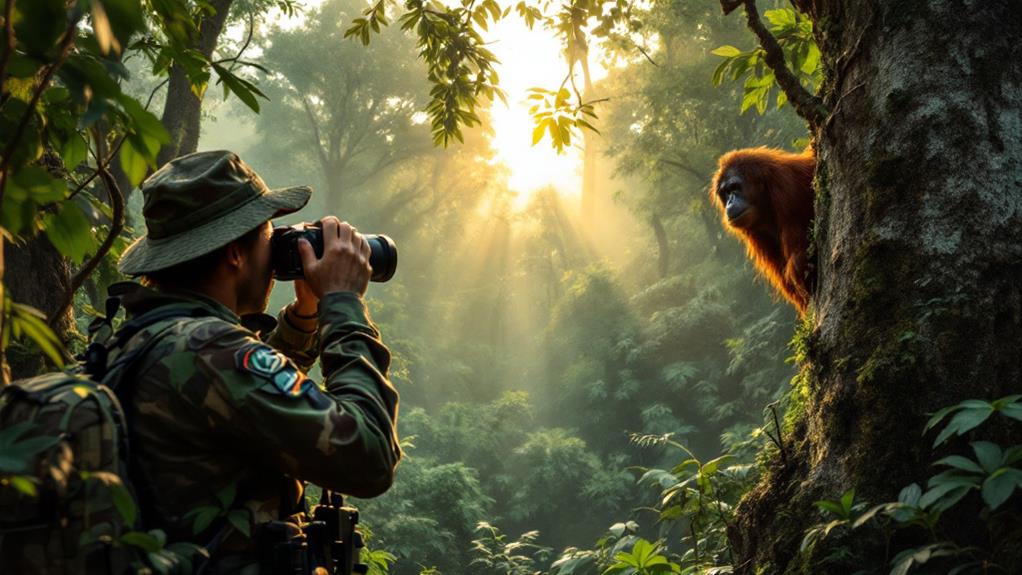Wildlife conservation techniques are powerful tools you can use to protect and restore our planet’s biodiversity. You’ll find a range of strategies, from habitat restoration and protection to captive breeding programs. Creating wildlife corridors helps connect fragmented habitats, while anti-poaching efforts safeguard endangered species. Advanced technology like GPS tracking and drones revolutionizes monitoring and protection. Community-based initiatives engage locals in conservation efforts, and sustainable resource management guarantees long-term ecosystem health. By implementing these techniques, you’re not just preserving individual species, but entire ecosystems. Dive deeper to discover how each method contributes to a more sustainable future for wildlife.
Habitat Restoration and Protection
At the heart of wildlife conservation lies habitat restoration and protection. You’ll find that these techniques are vital for maintaining biodiversity and ensuring the survival of various species. When you engage in habitat restoration, you’re actively repairing damaged ecosystems to their natural state. This process often involves removing invasive species, replanting native vegetation, and restoring natural water flows.
You can start by identifying areas that need restoration, such as polluted waterways or deforested lands. Once you’ve assessed the damage, you’ll develop a plan to address specific issues. This might include soil remediation, reintroducing native plant species, or creating wildlife corridors to connect fragmented habitats.
Protection is equally important. You’ll need to establish protected areas, such as national parks or wildlife reserves, to safeguard key habitats from human encroachment. You can also work with local communities to develop sustainable land-use practices that benefit both wildlife and people.
To effectively protect habitats, you’ll need to address threats like poaching, illegal logging, and climate change. This may involve implementing anti-poaching patrols, promoting sustainable forestry practices, and developing climate adaptation strategies for vulnerable ecosystems.
You’ll find that successful habitat restoration and protection require collaboration between scientists, conservationists, governments, and local communities. By working together, you can create thorough strategies that address the complex challenges facing wildlife and their habitats. Remember, your efforts in habitat restoration and protection are essential for preserving biodiversity and ensuring a healthy planet for future generations.
Captive Breeding Programs
Numerous wildlife conservation efforts rely on captive breeding programs as an vital tool. These programs aim to increase the population of endangered species by breeding them in controlled environments. You’ll find that captive breeding can help prevent extinction, reintroduce species to the wild, and maintain genetic diversity.
When you’re involved in a captive breeding program, you’ll need to create an environment that closely mimics the species’ natural habitat. This includes providing proper nutrition, temperature control, and social structures. You’ll also need to take into account genetic management to avoid inbreeding and maintain the species’ genetic diversity.
One of the main challenges you’ll face is preparing captive-bred animals for release into the wild. You’ll need to implement training programs to teach survival skills and minimize human dependency. It’s critical to gradually expose the animals to natural conditions and potential predators before release.
You should be aware that captive breeding isn’t without controversy. Critics argue that it can divert resources from habitat protection and may not address the root causes of species decline. Additionally, you’ll need to take into account the ethical implications of keeping animals in captivity.
Despite these challenges, captive breeding has successfully contributed to the recovery of several species. You can point to examples like the California condor, black-footed ferret, and Arabian oryx as success stories. However, it’s important to remember that captive breeding should be part of a thorough conservation strategy that includes habitat protection and addressing human-wildlife conflicts.
Wildlife Corridors

While captive breeding programs focus on increasing species populations, wildlife corridors address another significant aspect of conservation. These corridors are designed to connect fragmented habitats, allowing animals to move freely between different areas. You’ll find that these pathways are vital for maintaining genetic diversity, facilitating migration, and helping species adapt to climate change.
When you’re designing wildlife corridors, you’ll need to take into account various factors. First, identify the target species and their specific habitat requirements. You’ll want to create passages that mimic natural landscapes, incorporating vegetation, water sources, and appropriate terrain. It’s important to make these corridors wide enough to accommodate different species and reduce edge effects.
You’ll face challenges when implementing wildlife corridors, especially in urban or agricultural areas. You’ll need to work with landowners, local governments, and conservation organizations to secure the necessary land and resources. It’s essential to address potential conflicts with human activities, such as road crossings or farming practices.
To guarantee the effectiveness of wildlife corridors, you should implement monitoring programs. Use camera traps, GPS tracking, and genetic studies to assess how animals are using the corridors. You’ll want to evaluate the success of these pathways in maintaining population connectivity and adjust your strategies accordingly.
Remember that wildlife corridors aren’t just beneficial for animals. They can also provide ecosystem services like carbon sequestration and water filtration. By integrating these corridors into broader conservation plans, you’ll contribute to more resilient and interconnected ecosystems, ultimately supporting biodiversity and ecological balance.
Anti-Poaching Efforts
Anti-poaching efforts form an essential component of wildlife conservation. You’ll find that these initiatives are critical in protecting endangered species from illegal hunting and trafficking. To combat poaching effectively, conservation organizations and governments employ various strategies.
One key approach you’ll encounter is the use of advanced technology. Rangers now utilize drones, satellite imagery, and GPS tracking to monitor vast areas and detect suspicious activities. You’ll also see thermal cameras and acoustic sensors deployed to identify poachers, even in challenging terrains or at night.
Training and equipping park rangers is another important aspect you should be aware of. These frontline defenders receive specialized training in wildlife tracking, evidence collection, and self-defense. You’ll notice that many conservation areas have increased their ranger presence and improved their patrol strategies to deter poachers.
Community engagement is a strategy you shouldn’t overlook. By involving local communities in conservation efforts, you’re creating a network of allies against poaching. You’ll find programs that offer alternative livelihoods, education, and economic incentives to reduce the appeal of poaching.
Legal measures play a significant role in anti-poaching efforts. You’ll see many countries strengthening their wildlife protection laws and increasing penalties for poaching. International cooperation is critical, as you’ll observe joint operations targeting wildlife trafficking networks across borders.
Lastly, demand reduction campaigns are essential. You’ll encounter efforts to educate consumers and change attitudes towards wildlife products, aiming to decrease the market that drives poaching. By addressing both supply and demand, you’re tackling the issue from multiple angles.
Technological Tracking Solutions

Technological tracking solutions have revolutionized wildlife conservation efforts. You’ll find these innovative tools playing an essential role in monitoring and protecting endangered species across the globe. GPS collars, for instance, allow you to track animal movements in real-time, providing valuable data on migration patterns, habitat use, and potential threats.
Satellite imagery has become an indispensable asset in your conservation toolkit. You can use high-resolution images to monitor changes in vegetation, detect illegal logging, and identify poaching hotspots. This technology enables you to cover vast areas efficiently, making it easier to allocate resources where they’re needed most.
You’ll also find drones increasingly useful for wildlife surveys and anti-poaching patrols. These unmanned aerial vehicles can cover large distances quickly, capturing detailed footage and thermal images to locate animals or spot potential intruders in protected areas.
Camera traps have become more sophisticated, offering you remote monitoring capabilities. These motion-activated devices can capture photos or videos of elusive species, helping you estimate population sizes and study animal behavior without causing disturbance.
You can now use environmental DNA (eDNA) analysis to detect the presence of species in water bodies or soil samples. This non-invasive technique allows you to monitor biodiversity and track rare or hard-to-spot animals without direct observation.
Acoustic monitoring systems enable you to listen for specific animal calls or detect gunshots from poachers. By strategically placing these devices, you can gather data on species presence and respond quickly to potential threats.
Community-Based Conservation Initiatives
Community-based conservation initiatives stand as a powerful complement to technological solutions in wildlife protection. These programs empower local communities to actively participate in and benefit from conservation efforts, creating a sustainable approach to wildlife preservation.
You’ll find that successful community-based initiatives often involve education and awareness programs. These help locals understand the importance of wildlife conservation and its potential economic benefits. By learning about their local ecosystem, community members become more invested in protecting it.
Another key aspect is the development of alternative livelihoods. You can help reduce poaching and habitat destruction by providing communities with sustainable income sources that don’t rely on exploiting wildlife. This might include eco-tourism, sustainable agriculture, or handicraft production using non-threatened natural resources.
You should also consider implementing co-management strategies. These involve sharing decision-making power and responsibilities between government agencies and local communities. This approach guarantees that conservation efforts align with community needs and values.
It’s essential to establish benefit-sharing mechanisms. When communities directly benefit from conservation efforts, they’re more likely to support and actively participate in them. This could involve revenue sharing from tourism or employment opportunities in protected areas.
Lastly, don’t forget to incorporate traditional knowledge into conservation strategies. Local communities often possess valuable insights about their environment and wildlife. By integrating this knowledge with scientific approaches, you’ll create more effective and culturally appropriate conservation programs.
Sustainable Resource Management

Sustainable resource management goes hand in hand with effective wildlife conservation. It’s a vital approach that guarantees the long-term viability of ecosystems while meeting human needs. You’ll find that this strategy focuses on using natural resources in a way that doesn’t deplete them, allowing for their continuous availability.
To implement sustainable resource management, you need to take into account several key factors. First, assess the carrying capacity of the ecosystem you’re working with. This will help you determine how much resource extraction is possible without causing irreversible damage. Next, establish quotas and regulations to control harvesting rates. You’ll want to make certain these limits are based on scientific data and regularly updated to reflect changing conditions.
Implementing rotational use of resources is another effective technique. This approach allows areas to regenerate between periods of use, maintaining biodiversity and ecosystem health. You should also promote the use of alternative resources when possible to reduce pressure on vulnerable species or habitats.
Education and community involvement are essential for successful sustainable resource management. You’ll need to engage local communities, teaching them about the importance of conservation and involving them in decision-making processes. This approach fosters a sense of ownership and responsibility for natural resources.
Monitoring and adaptive management are key components of this strategy. You must regularly assess the impacts of resource use and adjust your management plans accordingly. By staying flexible and responsive to changes, you’ll be better equipped to maintain a balance between conservation and resource utilization.

Erzsebet Frey (Eli Frey) is an ecologist and online entrepreneur with a Master of Science in Ecology from the University of Belgrade. Originally from Serbia, she has lived in Sri Lanka since 2017. Eli has worked internationally in countries like Oman, Brazil, Germany, and Sri Lanka. In 2018, she expanded into SEO and blogging, completing courses from UC Davis and Edinburgh. Eli has founded multiple websites focused on biology, ecology, environmental science, sustainable and simple living, and outdoor activities. She enjoys creating nature and simple living videos on YouTube and participates in speleology, diving, and hiking.

